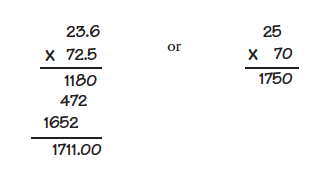Physical Address
$ 6.19 \space g \space HCl \div (36.458 \space ^g/_ \space HCl)$ $ 6 \space g \space HCl \div (36 \space ^g/_ \space HCl) = 0.1667 \space mol \space HCl $
Math for the MCAT: Everything You Need to Know
Learn key MCAT topics about MCAT math, plus practice questions and answers

(Note: This guide is part of our MCAT Physics series.)
Table of Contents
Part 1: Introduction
Part 2: Estimating and rounding numbers
a) Multiplication
b) Division
c) Example problem
Part 3: Logarithms
a) Logarithm rules
b) Common applications of logarithms
c) Example problem
Part 4: Strategies for eliminating answer choices
a) Significant figures
b) Exponents
c) Example problem
Part 5: Fractions
a) Addition and subtraction
b) Multiplication and division
c) Application: thin lens equation
d) Example problem
Part 6: Passage-based questions and answers
Part 7: Standalone questions and answers
Part 1: Introduction
While the MCAT does not permit the use of a calculator, the exam still contains questions that will require mathematical calculations—particularly in the context of physics and chemistry. Fine-tuning your math skills can thus significantly improve your ability to work through these test questions.
While many of these math skills include basic addition, subtraction, multiplication, and addition, this section contains a few additional concepts that are important to brush up on for the MCAT, including logarithm rules and manipulating fractions. At the end of this guide, we have included several practice problems for you to practice with.
Part 2: Estimating and rounding numbers
Estimating and rounding numbers are useful skills on the MCAT, as they can help you calculate problems more effectively. This section contains important reminders to guide you through estimating and rounding.
a) Multiplication
Suppose we’re trying to multiply 6.84 x 2.25. With no calculator available, how can we best approximate this answer in a short amount of time?
When multiplying numbers with many nonzero digits, rounding can give us more digestible numbers to work with. Rounding these numbers to one decimal place or a whole number can greatly simplify our mathematical calculations.
To determine how much to round numbers, it may be helpful to first look at the answer choices that are presented. If the answer choices are closer together, then it would be better for us to round to one fewer digit to keep our calculations more accurate. If our answer choices are farther apart, then we can get away with rounding more.
To keep our calculations accurate, we can also compensate for our rounding for each digit. If we decide to round one number up, we should round the other number down, so that we stay closer to the true value. For instance, if we round 6.84 to 6.8, then we should round 2.25 to 2.3.
Suppose we chose to round 2.25 down to 2.2 instead. How would this compare to the correct answer and the answer provided by using 2.3?
$$6.84 \times 2.25 = 15.39 $$ $$6.8 \times 2.3 = 15.64 \rightarrow 15.6 $$ $$ 6.8 \times 2.2 = 14.96 \rightarrow 15.0 $$
Our calculation is further from the correct answer when we use 2.2. By compensating for rounding and using the digit 2.3, we get a result closer to the actual answer of 15.39.
b) Division
Estimating and rounding in division problems is similar to what we do for multiplication problems. As with multiplication, we first check the answer choices to determine how much we should round.
In division, however, we make different adjustments when we compensate for our rounding. To keep our numbers proportional to each other, both the dividend and divisor should be shifted in similar directions.
Say we want to divide 19.58 by 4.67. If we decide to round 19.58 up to 20, then we should also round 4.67 up to 5. Doing so will give us a result of 4, which is close to the actual 4.19.
c) Example problem
Let’s work through an example of a mathematical problem that is likely to be found on the MCAT.
A student adds 6.19 grams of solid hydrochloric acid to 0.0500 L of water. What is the molarity of the resulting solution?
Molarity is given in moles per liter. To calculate the molarity of this solution, we will start by determining the number of moles of hydrochloric acid (HCl). First, we calculate the molar mass of HCl.
$$ 1.008 \space ^g/_ \space + 35.45 \space ^g/_ = 36.458 \space ^g/_ $$
Then, we use this molar mass to convert the mass of HCl to moles. We can round both numbers down to simplify our calculation.
$$ 6.19 \space g \space HCl \div (36.458 \space ^g/_ \space HCl)$$ $$ 6 \space g \space HCl \div (36 \space ^g/_ \space HCl) = 0.1667 \space mol \space HCl $$
We then divide this value by the volume of the solution to determine molarity.
$$ 0.1667 \space mol \space HCl \space \div 0.0500 L = 3.33 M \space HCl $$
The approximate molarity of the solution is thus calculated to be 3.33M HCl.
How to Survive MCAT Math Without a Calculator
The MCAT is essentially a science test, but you’ll still need a solid grasp of math fundamentals to score big —and you cannot use a calculator.
Our experts compiled a list of MCAT math topics to prep for along with some tips for doing math calculations by hand.
What math is covered on the MCAT?

The MCAT is primarily a conceptual exam, with little actual mathematical computation. Any math that is on the MCAT is fundamental: just arithmetic, algebra, and trigonometry. There is absolutely no calculus on the MCAT. Math-based problems will appear mostly in the Chemical and Physical Foundations of Biological Systems section . On the other science sections, a basic understanding of statistics as used in research will be helpful.
MCAT Math Tricks
1. Practice for not having a calculator.
You aren’t allowed to use a calculator on the MCAT, so you need to practice doing arithmetic calculations by hand. Fortunately, the amount of calculation you’ll have to do is small. See how you score on our free MCAT practice test .
2. You only have to be reasonably accurate.
Try to make approximations so that you can do the math quickly. On the Chem/Phys section, your MCAT time per question is approximately 1.4 minutes (95 minutes for 67 questions). There simply isn’t time for lengthy, complicated math!
Here’s how it works. Which of the following calculations for figuring out the value of 23.6 × 72.5 is faster?

In the one-step calculation on the right, we approximated: 23.6 ≈ 25 and 72.5 ≈ 70. The answer we got in just a few seconds differs from the precise answer by only 2%. For the MCAT, you should always try to approximate so that you can do the math quickly.
Free MCAT Practice Tests & Events
Evaluate and improve your MCAT score.
3. Remember to pace yourself
If you find yourself writing out convoluted calculations on your scratch paper when you’re working through math-based MCAT problems, it’s important that you recognize that you’re not using your time efficiently. Say to yourself, “I’m wasting valuable time trying to get a precise answer, when I don’t need to be precise.”
4. Include some math review in your MCAT prep
Are you rusty in any of these areas? You’ll want to brush up on a few key math concepts during your MCAT prep .
Arithmetic, Algebra, Graphs
- Scientific notation, exponents, and radicals
- Fractions, ratios, and percents
- Equations and inequalities
- x-yplane, lines, and other graphs
The concept of proportionality is fundamental to analyzing the behavior of many physical phenomena and is a common topic for MCAT questions.
Trigonometry
- Pythagorean Theorem
- Sine, cosine, and tangent functions
- Sine and cosine values of common angles
- Inverse functions
- Radian measure
Vectors
- Scalars and vectors
- Addition and subtraction of vectors
- Scalar multiplication
- Vector projections and components
Proportions
- Direct proportions
- Inverse proportions
Logarithms
Basic Statistics
- Mean, median, mode, range
- Standard deviation, normal distributions
- Percentile
- Variables, sample size, random samples, correlation
- Reliability, validity
- Randomized controlled trial, double-blind experiment
Research Methods
- Graphical analysis and interpretation
- Determining whether results are supported by data presented in figures
- Demonstrating an understanding of basic statistics and research methods
- Interpreting data presented in graphs, figures, and tables
- Drawing conclusions about data and methodology
Get your maximum score with expert MCAT prep
Learn More
Read More
The Staff of The Princeton Review
For more than 40 years, students and families have trusted The Princeton Review to help them get into their dream schools. We help students succeed in high school and beyond by giving them resources for better grades, better test scores, and stronger college applications. Follow us on Twitter: @ThePrincetonRev.









